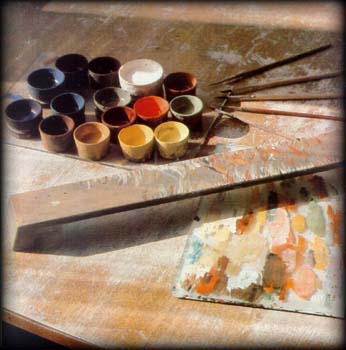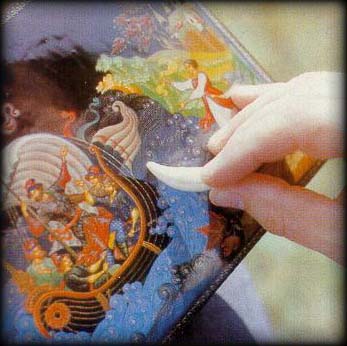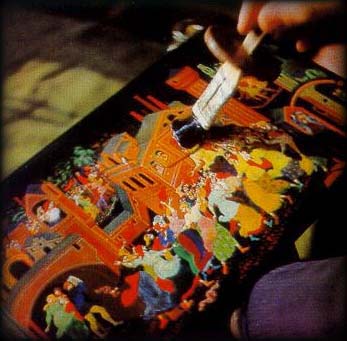╘ Black Lacquers Co-operative, 1999
About original technique of making, painting and
polishing of lacquered boxes.
How to try to distinguish fakes.
Making of a box from papier-mБchИ. There are fore schools of Russian lacquered miniatures art: Palekh, Fedoskino, Kholui and Mstera (Lipetsk, Sergiev Posad and etc. are not the real art schools, but mostly places of making bad copies and cheap imitations). Actually, Fedoskino was the first Russian art school that adopted the style of oriental ╚lakwear╩ (see the certain page). Palekh was the second and then, a bit later Mstera and Kholui started to use the same technique. A Palekh box begins with ordinary cardboard, which is cut into narrow strips and pasted with glue made from wheat flour. These strips are then built round a form that gives the size and shape of the box, and when the right thickness is achieved it is put into a mechanical press before being dried for about fifteen days at room temperature. After a bath in boiling linseed oil for twenty-four hours, the cardboard is heated for four days in an iron box, itself within an oven, at 120 degrees Centigrade. At this stage it▓s becoming as strong as the hardest wood, enabling carpenters and joiners to grind the box and fasten on the bottom and the metal hinges.
It is then sanded and primed with three coats of a solution containing ash and river clay, being oven-dried and smoothed down between each layer. The entire outer surface is now ready to be painted with a mixture of ash and oil lacquer. (For the red interior cinnabar and carmine blended with this lacquer are used). Three or four coatings of a different lacquer are then applied, with twelve hours' drying time between each. The box now goes to the artist to be painted, and he makes a pencil sketch of the subject.
 Preparations for the painting (surface, egg tempera, gold). However, now brilliantly
polished, the lacquer surface is too smooth to hold paint, so the artist, wrapping a damp cloth round his finger,
gently rubs on some pumice powder, to make the top, or sometimes also its sides, matte. Then with his finger
he rubs chalk into the back of the drawing, which he now presses on to the lid of the box, transferring the
outline with a wooden-handled needle called a ╚tzirovka╩, the excess chalk being brushed away with a goose
feather.
Preparations for the painting (surface, egg tempera, gold). However, now brilliantly
polished, the lacquer surface is too smooth to hold paint, so the artist, wrapping a damp cloth round his finger,
gently rubs on some pumice powder, to make the top, or sometimes also its sides, matte. Then with his finger
he rubs chalk into the back of the drawing, which he now presses on to the lid of the box, transferring the
outline with a wooden-handled needle called a ╚tzirovka╩, the excess chalk being brushed away with a goose
feather.
As black tends to absorb colours, to give them permanence the artist prepares the surface with a whiting solution, which forms a wash over the areas that will have a lighter aspect, avoiding black spaces such as the sky.
Now comes the preparation of tempera in the following manner. The artist takes one ordinary hen's egg (but all painters prefer to use the local eggs) of any size. In its blunt end he makes a hole which allows the white to drop out. After cleaning the eggshell from inside with his index finger, he takes the yolk into his right hand, and passes it from hand to hand until the final traces of albumen are removed, before piercing it to allow it to run back into the shell, which he now fills to the top with vinegar, mixing the two liquids with a small spatula.
Traditionally these instructions apply only to an egg taken from a hen in winter, for it is only then that the proportions are right, a summer egg having too much fat and therefore needing more vinegar. This betrays the iconic origins of the technique: the rest of the year the icon painter would farm, and it was only when the egg, that ages-old symbol of perfection, provided ideal distemper, that the time had come to paint an icon.
In fact, the only major difference in the procedure for making tempera between ancient Palekh and modern Palekh is in the use of vinegar, kvass (the popular Russian beverage made from rye bread) previously being used much more widely.
Once the tempera is ready paint pigments are then blended several times on a china dish with different proportions of the egg mixture, to give different tones.
A china dish also serves for the preparation of gold, which necessitates two grams of gum arabic to every ten sheets of gold. The proportion of gum arabic is strictly controlled, for too little means that the gold can be rubbed off the box or lacquer article; too much and the gold will not shine.
The gumarabic is put on the dish and a little water added. The artist takes 12x7 sheet of 24K gold, a sheet so light that the slightest breeze can lift it and make it stick somewhere, and breaks it up with his fingers in vertical movements. The other nine sheets are added one by one, and for one and half-hours the artist moves his finger left and right in the dish, adding drops of water. Then another two grams of gum arabic are added, together with a third of a glass of water. This is put aside for twenty minutes, allowing the gold to sink and the mixture to be skimmed. The dish is then dried above a lamp, taking cares not to let in any impurities, and is ready for painting.
Aluminium is used rather than silver because the latter goes yellow at high temperatures. This, however, comes as a coarse powder, which has to be ground with glass, as does bronze when it is used.
 Painting. Painting is done in seven stages based closely on the procedures for icon
painting. Paint is applied at the third stage, with finer and finer details being added until the details on the
naked parts of the body - such as the fingernails - are added at the seventh. Gold is used only at this final stage.
In the classic method the artists make their own squirrel-hair brushes, the finer work is done under a
magnifying glass, with the very finest work being achieved with single hair. Gold leaf is traditionally
burnished with a wolf's tooth.
Painting. Painting is done in seven stages based closely on the procedures for icon
painting. Paint is applied at the third stage, with finer and finer details being added until the details on the
naked parts of the body - such as the fingernails - are added at the seventh. Gold is used only at this final stage.
In the classic method the artists make their own squirrel-hair brushes, the finer work is done under a
magnifying glass, with the very finest work being achieved with single hair. Gold leaf is traditionally
burnished with a wolf's tooth.
 Polishing.
Polishing.
When the gold-work is finished the box goes to craftsman-polisher. He put the layer of clear white
lacquer and then dries box in an oven at 80 Centidegrees for 24 hours. Then removes bubbles and other
inclusions with a piece of glass and repeat all this procedure for seven times.
After that he takes the box with seven layer of lacquer and polishes it using specials mechanical polishing device with big spinning circle, covered with smooth fabric - mainly flannel. He uses the solution of chromic oxide in water for this process.
 The final polishing is made exclusively by hand to give the lacquer surface the warm of human
hand and in order to polish small areas, which are impossible to polish by mechanical device. This final
process called "tender-mother care" and chromic oxide is used for it.
The final polishing is made exclusively by hand to give the lacquer surface the warm of human
hand and in order to polish small areas, which are impossible to polish by mechanical device. This final
process called "tender-mother care" and chromic oxide is used for it.
Take care of fakes!
Fakes - is for the sure the biggest and most serious problems of nowadays on the market of Russian lacquered boxes. They are absolutely everywhere √ in the many galleries and gift shops all over the world, in many Internet (specially American) sites, in many tourist places of Moscow and so on. For those who see it for the first time it is not easy at all to distinguish a genuine Palekh work from fake. It needs a trained eye. Surely not everybody has one. Collectors, especially Western ones, all too often go by the inscription (or signature) and the trademark. The trouble is that it is not very difficult with a painter just with basic education to fake both signature and trademark. As a piece of advice for beginners, a genuine Palekh piece must have at least two distinctive features. First, the gold touchup lines (probeli), lines emphasizing the volume of the objects in the painting. A painter must have high skill to apply gold touchup lines properly; not all Palekh masters can do it. On a fake painting the gold lines are haphazard. Some fakers try to ornate the painting with lines bearing no construction sense, with the result that the ornament looks quite incongruous. Another thing, which may give a faker away, is his inability to use the technique of multi-layer brushwork (plavi). The technique is needed so sophisticated that painters who graduated from the Palekh art school take many years to master it. Unfortunately, an innocent buyer may not see the difference between real multi-layer brushwork and primitive colouring.Here we are not talking about other more sophisticated attributes, which differ original box from fake. But we can mention them: a special technique in painting the naked places of people body (legs, arms, faces), special proportions of figures, special rules of painting mounts, trees, other floral objects. Every professional expert knows nearly each painter in Palekh and knows the unrepeatable style of all their works - so he can see the masterpiece and compare the signature of the painter with the style of current work and if it is certain difference - he tell for sure - This is fake! After having some experience of collecting and looking at the real ones, if you have a good eye for the beauty √ you▓ll got it yourself, before that - trust the respectful sources not the street vendors.
Many thanks to Maxim Lucy √ first western lady with the real love to Russian lacquers.